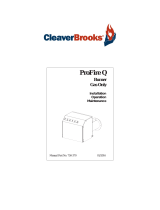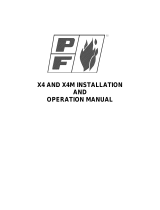Page is loading ...

Installation - Maintenance
MULTIPLEX blown gas burner
The MP burner range of compact industrial packaged gas burners covers outputs up to 150 therms, using a
very stable “nozzle-mixing” combustion head and is suitable for use on Natural, LPG or Towns Gas (type must
be specified at time of ordering). They are suitable for firing a wide range of industrial applications.
The control system and components used in conjunction with the MULTIPLEX burner should be in accordance
with BS5885 and recommendations and codes of practice set out by BRITISH GAS where the equipment is for
use in the UK, and to the relevant authority in other countries.
The instructions given by NU-WAY assume that these conditions have been met by the plant manufacturers
and/or installers. For general data see Multiplex Data Sheet.
BURNER MOUNTING AND COMBUSTION TUNNEL RECOMMENDATIONS
The MULTIPLEX burner would normally be provided with one of three tunnel options. The mounting
requirements external to the combustion chamber would hold for all three options. The internal requirements
will however vary and guidance for mounting is given. Nu-way will advise on any mounting problems you may
have and make recommendations on choice of tunnel materials if required.
External Mounting
All burners are provided with a mounting flange which is pre-drilled to dimensions given on the data sheet.
Combustion chamber fire hole should be required dimensions (See dimensions in Data Sheet).
Screwed studs or alternative fixings should be provided on burner flange holes centres.
Burner may be mounted to chamber in any one of the four available mounting positions provided by the
mounting flange.
When the burner is mounted to the furnace front withdrawal distance equal to the overall length of the burner
including combustion tunnel should always be allowed at the rear of the burner unit.
Gas pipework into the burner should be such as to include an elbow and union connection to ensure freedom of
removal of internal parts of the burner for service. Care should be exercised in assembly of the gas pipework to
ensure electrode extensions are not damaged. Care should be taken to ensure that it seats evenly and
squarely to the chamber. A gasket, gasket rope or furnace cement should be used to prevent leakage.
page 1
SERIES
MP

NO TUNNEL FITTED
Customer to provide burner combustion zone in the wall of the combustion chamber. The dimensions of this
zone to be in line with the dimensions shown on the Nu-way MULTIPLEX Data Sheet. Care must be taken to
ensure that the zone is cut or formed at right angles to the burner mounting flange and is concentric.
A shoulder must be cut/formed to allow the cast section of the burners (MP1-4) to fit inside the chamber.
MP HEAT RESISTANT STEEL TUNNEL FITTED
Burners with SS tunnels would normally be provided for low temperature operation as detailed in the Data
Sheet.
The fire hole provided should be as such as to allow nominal 5 to 8mm air gap around the SS tunnel.
REFRACTORY QUARL
Burners with refractory quarls and holders would normally be provided for high temperature applications and in
particular where existing heavy refractory installation is built into the combustion chamber. The Nu-way
combustion quarl and holder would normally be fitted into the combustion chamber before
the burner is fitted.
page 2

GAS AND ELECTRICAL CONNECTIONS
When connecting a gas supply it is desirable to install a manual shut-off valve together with a suitable pipe
union at or near the burner. The burner assembly should not be used to support the incoming gas supply,
suitable brackets or hangers should be used for this purpose. Care should be taken to ensure that the
incoming gas piping is sized correctly to prevent excessive drops, also that gas connections are pressure tight
and gas line purged and pressure tested in accordance with local gas authority requirements or legislation.
Wiring of the burner should be in accordance with the wiring standards. A suitable mains isolator should be
placed in a convenient location, and the final electrical connections to the burner should be in flexible conduits.
It is vital that the live and neutral wires are connected to their appropriate terminal as reversal could present a
hazard, also the earth bonding must be checked to ensure a good earth connection (poor earth connections are
often the cause of faulty burner operation when using the flame probe detection).
Note: Gas piping must not be used for earthing.
The burners are all of the ‘expanding flame’ type pilot system and can use ‘intermittent’, interrupted’, or ‘semi-
automatic’ flame failure control boxes.
FIRST START-UP
The procedure given below is only a guide to commissioning which should be undertaken by a trained and
experienced combustion engineer.
1. Close main cock.
2. Check electricity supply is off.
3. Check gas and electric connections are sound.
4. Purge air from gas supply pipe to burner according to standard purge procedure.
5. Establish correct blower direction of rotation of fan or air blower.
Momentarily energise starter and observe direction of rotation of motor or impeller. If not rotating toward
blower discharge electrically reverse motor rotation and re-check.
6. Disconnect Automatic Control Motor Linkage or if fitted turn Auto/Manual control switch to Manual.
Disconnect linkages between control motor and control valves so that the latter are free to be operated
manually.
7. Air purge combustion chamber (with gas cocks still closed).
Start all system/process circulating and exhaust fans and move burner firing rate control valve to fully open
position so that air only will be flowing through burners and combustion chamber, purging any explosive
vapours that may have accumulated prior to initial start-up or during a periodic shutdown. When it is certain
that the system is completely free of explosive vapours, return burner control valve to low fire position.
(Length of purge required will usually be specified by insurance or approval agency having jurisdiction), but
will normally be not less than 30 seconds at full air flow or five volume changes of all combustion chamber
and gas passages up to the flue exit from the plant.
8. Ensure sequence control system is operating and automatic gas control valve are operating and spark is
present and that control goes to ‘flame failure’. (This test with main gas cock in Off position).
page 3

9. LOW FIRE (PILOT START GAS AND AIR SETTINGS)
(Minimum Input Rate)
Set air butterfly valve to give approximately 15mm (0.6”) wg air pressure at inlet to burner (above
combustion chamber pressure/suction).
Slightly ‘crack’ open gas flow control valve.
Initiate start sequence, if burner fails to ignite, slightly increase gas flow at butterfly valve and reset
sequence controller and initiate a new start sequence repeating as many items as necessary to give a
smooth start. (The burner should not light with an ignition shock or noise – if this is the case the gas flow
rate is generally too high for a safe start-up).
N/B: It is recommended that the start gas rate should never exceed 10% of burner rating or 25,000
kcal/h (100,000 Btu/h) whichever is the lower.
10. FULL FIRE
With servomotor linkages disconnected and flame established manually increase flow rate of air and gas to
achieve required output. This will be FULL FIRE position.
N.B: Always move air valve first on increasing flame and gas valve on decreasing flame size. It is
dangerous to produce gas rich flames.
Reconnect control linkages and drive motor and ensure they are free to travel over full firing range.
Check firing range and if necessary adjust characterisation of control valve system for best operation and
turndown required.
11. With burner firing ensure normal pressure connected air pressure switch is correctly set for burner
operation. It should be set to break electrical continuity if the air pressure setting fails.
12. Observe flame at different firing rates and re-check allied safety control and all process interlocks and
controls.
OPERATING INSTRUCTIONS
TO START
(Fully Automatic – Previously Commissioned System)
1. Open PILOT GAS COCK and MAIN GAS COCK.
2. Press START or IGNITION BUTTON.
TO START
(Manual - Previously Commissioned System)
1. Make sure MAIN GAS COCK is closed.
2. Make sure the burner firing rate is at predetermined low fire position.
3. Start any process circulating and exhaust fans.
4. Energise system control panel (if applicable).
5. Start BURNER FAN BLOWER MOTOR.
6. Press IGNITION BUTTON or apply external ignition source.
7. Open MAIN GAS COCK slowly until burner ignites.
page 4

TO STOP (Either Manual or Automatic System)
1. Close MAIN and PILOT GAS COCK.
2. Allow burner to continue operating until flame goes out (as seen through observation port on rear of
burner).
3. De-energise system control panel and BURNER FAN BLOWER MOTOR.
4. If the combustion chamber is under positive pressure allow BURNER BLOWER to run while cooling down
system.
MAINTENANCE AND SPARES
The following should be carried six-monthly or every 1000 hours, whichever is the shorter:-
Turn off gas and electricity supplies.
Clean the burner, a clean burner looks better and works better.
Check the electrodes, make sure they are clean and set correctly.
Check gas pipes and electrical connections. Bearings of electric motors provided with oilers should be
lubricated with six drops of light machine oil. Ball bearing motors are normally grease packed for life.
Connect a manometer to the test point between the manual gas cock and the safety shut-off valve. Turn
the manual gas cock on and then off. Mains gas pressure is then between the valves and this pressure will
be indicated on the manometer. Any leakage of gas past the main or pilot safety shut-off valves, or from a
pipe joint will reduce the pressure. If this pressure remains constant over a period of not less than one
minute, no leakage is taking place. Should gas pressure not remain constant – please call a Service
Engineer to properly check, clean and test the gas valve system.
Turn on the gas and electricity and start the burner.
Check the flame signal.
Restrict the air inlet to the combustion air fan. The burner should shut down under the action of the air
pressure switch.
The burner running, close the manual gas cock. The burner will go to lockout and any alarms fitted should
operate. Reset the control box.
page 5

ELECTRODE GAPS
Spark Electrode
These are pre-bent at the factory and should be set with the internals of the burner removed (withdraw the
burner by removing four or eight screws in the back plate casting), after disconnecting the gas supply at the
burner union. Gap should be nominally 2.5mm.
Replacement of end section can be achieved by unscrewing the final bent section with insulation from the front
(nozzle end) of the burner.
These are pre-bent at the factory as is the spark electrode and are replaced in the same way.
For Spares requirements the main burner components are as follows:-
page 6

Spark and flame failure electrodes are built up as follows:-
page 7
1. Back Insulator
2. Compression Fitting
3. Brass Connector Sleeve
4. Washer
5. Internal Insulator (Ignition)
6. Internal Insulator (Flame Probe)
7. Kanthol Ignition & Flame Probes.
Note:
All enquiries should quote details off burner
nameplate. For MPO burners probe details
may vary from those shown.

Enertech Limited,
P O Box 1,
Vines Lane
Droitwich,
Worcestershire,
WR9 8NA
Tel: +44 (0) 1905 794331 Fax: +44 (0) 1905 794017
/


